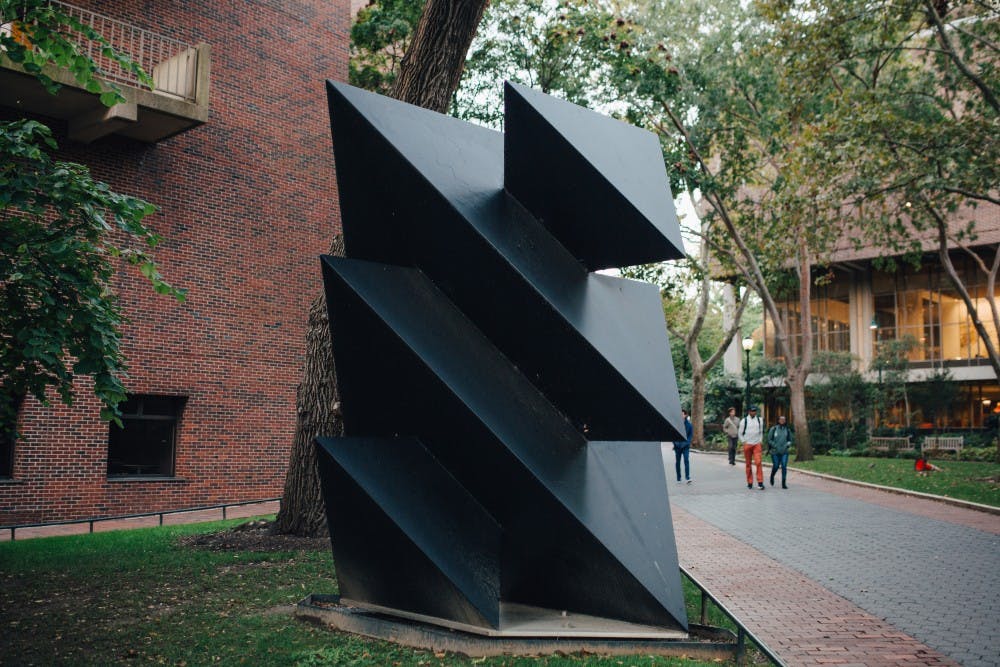You can't miss it. You've seen it a thousand times. But no doubt it was the last thing on your mind each time you hurried to classes or strolled through to grab a meal.
Robert Fredenthal's "Black Forest" is nondescript. It stands at the corner of 34th Street and Walnut—a leaning stack of black tetrahedrons of which no two angles look the same. Each plane casts a shadow interlocked with its unshadowed counterpart, forming patterns of light and dark. Its sharp edges and sleek angles, which might have clashed anywhere else, seem to fit together perfectly like pieces in a puzzle. This geometric masterpiece has a story to tell: the story of its artist, who lived a life to laugh and cry for.
Hailing from a family of artists, Robert Fredenthal was a student at Penn who studied at the Graduate School of Fine Arts in Architecture. His father was an acclaimed watercolor painter, and his mother was a respected cloth weaver and fabric designer. His sister, Ruth Ann, is now an internationally known painter based in New York. But Fredenthal's story was never as straightforward.
At age 24, his studies were slowed due to the onset of Parkinson's disease, as the ailment crippled his motor abilities and made it increasingly difficult to draw or create large installations. In 1964, when Fredenthal finally graduated with his architecture degree, he had diverged from a career in architecture and found a new creative outlet, one specializing in geometrical sculptures. Though his illness only worsened with time, eventually forcing him into a wheelchair, Fredenthal persisted. His passion in the arts drove him, and he settled on creating precise models and smaller constructions of artwork via the help of assistants.
Fredenthal would instruct his assistants by word of mouth, speaking of his vision of cubes and tetrahedrons, then correcting them here and there as the model was created. The result? Shelf upon shelf of geometric cardboard models, each an artistic rendering of the same simple shapes, but constructed so no two were alike.
When speaking of Fredenthal's work process, Jim Simmons, a friend and former model creator, notes how "...it was so serious and so uncompromising," requiring focus on the details of logic and a mastery in precision. Yet once the work was finished, Fredenthal would have so much fun naming the pieces, because that, as Simmon continues, was "...when his sense of humor came out." From naming one artwork "Blockhead" to calling another "Party Animals," Fredenthal's lighthearted outlook in life was one to admire. The joy he took in naming his art made the pieces human, softening the stiff lines of geometry and imbuing them with meaning.
To him, no obstacle or circumstance was worth dimming his character over. Always, his humor shone through. Recalling Fredenthal's routine of taking medication, his friends would chuckle at the memory of his nonchalance whenever pills scattered out of his shaky grasp and spilled onto the floor. While his friend John Phillips struggled with pushing his wheelchair, "getting his bag caught on the doorknob, and his leg caught..." Fredenthal never once chastised him. A smile was all.
As Phillips recalls, "he didn't mind in some ways the hypermotion, 'cause it made him feel alive. What he hated the most was being frozen." To Fredenthal, the fact that he had so much to give yet so little to live was an obstacle to overcome. His creativity and his lighthearted personality were stifled by Parkinson's, but he never despaired. His legacy of laughter and artwork are indicative of Fredenthal's perseverance.
At his funeral in the summer of 2010, beneath the shade of dappled grove and surrounded by family and friends, Simmons toasted Fredenthal, "...in remembrance of a great man, with a great sense of humor." His ashes were buried beneath a bushel of pink and purple blossoms. To this day, Robinson Fredenthal continues his mission to breath life into everything, even in death—be it a flowering bush or a stack of black tetrahedrons you might just pass the next time you head to Hill.

